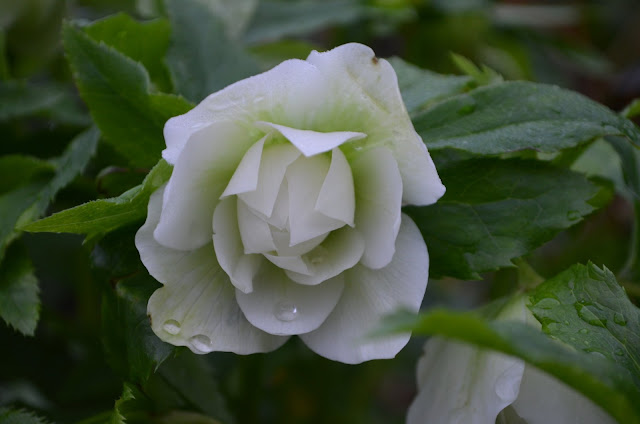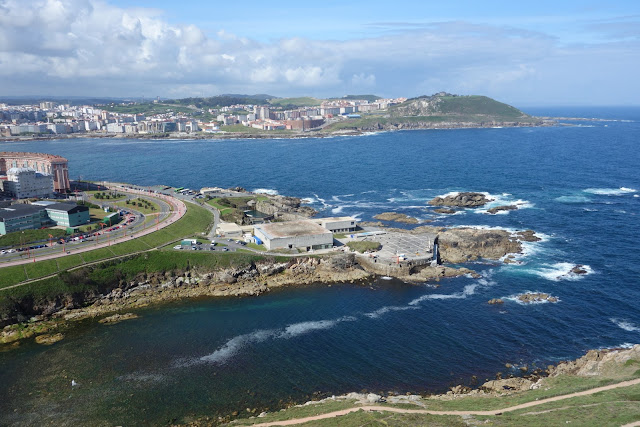The third year since purchase and Mrs McNamara has been in flower for a week. In September I subjected her to some terrible damage with a sharp spade when my aluminium plant label got separated from the bulbs it was supposed to safeguard. Bulbs got minced. I instantly covered them with soil, far far too late, feeling as guilty as if I had committed a mortal sin and waited to see what would survive. Well five flowers have a tale to tell and very stately they are too. As for the name, "Judy's Snowdrops" would have me believe the correct spelling is "Mrs Macnamara" as that is the family name. (See my post last year.) She is the classic snowdrop, early flowering and a weather and spade beater.
“Snowdrops and my heart I’ll bring” (Christina Rosetti) ... a blog about snowdrops .............. plants ... seasons .... gardens ....
Narcissus cantabricus ssp cantabricus & Narcissus 'Tête-à-Tête'
Two very contrasting dwarf narcissus today. Narcissus cantabricus ssp cantabricus was purchased as a single bulb and afterthought from Pottertons Nursery. It is a tiny bulb and flower, smaller than my other hoops and a very pale cream, almost white. The richly coloured stamen contrasts nicely with the flower. A second flower bud is showing.
Narcissus "Tête-à-Tête" was forced for early flower, four small bulbs producing many bicoloured flowers throughout the Christmas period. Purchased for 75 pence a pot at our local garden centre, the bulb is ubiquitous, appearing from supermarket shelf to specialist nursery. The bulb is prolific in both flower stems and for reproduction. The French translation is "head to head" on account, I believed, of the sheer accumulation of flower heads piling on top of one another. Not strictly true, I read in that excellent journal PHDaff, where the origins of the bulb are said to go back to 1949 and Alec Gray, the Cornish breeder whose other excellent miniature is "Sundial". Brash and flash it may be, but Tête-à-Tête" is the blockbuster of the commercial miniature daffodil world, selling in the many millions. It sits on our front step, 75 pence well spent. Maybe I should call this blog the "Spendthrift Gardener".
Cleethorpes Beach, Meridian Line, Windsurfers and First World War Forts
A house full of family (see New Year's Eve) is at times a rumbustious affair so after saying our farewells, to clear the head, for the second time in three days we walked for miles along Cleethorpes beach and salt marshes. We passed the Greenwich Meridian line that crosses the Humber Estuary, first entering Britain at Withernsea and then passing through Cleethorpes. The stainless steel plate crossing the walkway has withstood the rigours of time and footfall since being presented to the town in 1930 by the Sheffield Steelworks, Hadfields Ltd. Tough stuff. The signpost and granite globe were erected in October.
The Humber Estuary drains something like 20% of England's land mass so the water that is presently flooding Northern Yorkshire flows here.
Birds flock in their many thousands to over-winter on the rich marshland. The egret tested my zoom lens.
Wind surfers and one of the two estuary forts constructed in 1914 to defend the coast. The forts are lonely features of the seascape now. In the far distance behind the close-up of the windsurfer is the second fort.
And here in the thin winter sun, the sea defences and vast sands have a beauty.
The Humber Estuary drains something like 20% of England's land mass so the water that is presently flooding Northern Yorkshire flows here.
Birds flock in their many thousands to over-winter on the rich marshland. The egret tested my zoom lens.
Wind surfers and one of the two estuary forts constructed in 1914 to defend the coast. The forts are lonely features of the seascape now. In the far distance behind the close-up of the windsurfer is the second fort.
And here in the thin winter sun, the sea defences and vast sands have a beauty.
Helleborus × hybridus 'Harvington Double White"
We all have our favourite winter plants and this is one of mine. Although I featured it here last year, the first flower of the prolific 'Harvington Double White" is photographed again late yesterday afternoon. I have other earlier flowering hellebores and some more recent and pricey specimens from the Stamford based Twelve Nunns nursery. The double white is the best however. One bloom today, prolific exuberance promised for tomorrow. It is easy in this semi-cupped state to see why it is called the Christmas Rose notwithstanding the presence of actual roses still in flower due to a total lack of frost this year.
Bodysgallen Hall Gardens, North Wales, 11th August 2011
Forde Abbey and its Mighty Fountain, 26th July 2014
I have never been inside Forde Abbey as it was felt hosting a wedding to be more important than hosting the two of us. On a lovely July day in this lovely county of Dorset I was not so disappointed for we were there to see the fountain, the highest powered fountain in England reaching a height of up to 160 ft. It is not some historic creation, being constructed in 2005. The spectacle is eagerly awaited by visitors and a sense of excitement pervaded the gardens. It did not disappoint as the waters crashed down to the Mermaid Pond. I had to turn the camera sideways to capture the height!
Narcissus "Lemon Flare", Christmas Day
A Merry Christmas to one and all. I decided that my Christmas petticoat hoop is "Lemon Flare", obtained from Anne Wright although the original hybridizer was the Ulsterman, Brian Duncan. He began hybridizing way back in 1964, concentrating rather more recently on miniatures. He registered the bulb in 2013 and "Lemon Flare" seems one of the most robust bulbocodium daffodils this year, This was photographed on Wednesday, the flowers having filled out nicely since I featured them earlier in the week. Growing these distinctly early flowering narcissus outdoors does show up their seemingly fragile nature in the gale force winds. I say "seemingly" for they do bounce back. "Lemon Flare" in particular does not lack for resilience. I'm sure in a normal winter they would not be so early, other varieties of snowdrop and daffodil being perhaps two weeks premature.
Taking photographs with my little compact was fun in the gales. The blessed things just would not keep still and in focus. Which reminds me that we have six grandchildren here this Christmas.
.
Taking photographs with my little compact was fun in the gales. The blessed things just would not keep still and in focus. Which reminds me that we have six grandchildren here this Christmas.
.
Kew Gardens Davies Alpine House & Waterlily House, 4th May 2014
Opened in 2006 the Davies Alpine House is a modern take on the glass houses that have been such a feature of the world famous gardens at Kew. In the state of the art ventilated and lit glasshouse it is possible to grow alpines in a way I, funnily enough, fail to do so. The primulas in particular caught my eye.
Completed in 1852, Richard Turner's iron work is a feature of the Waterlily House and, for a time, both the images below adorned my computer as a background. Were it not for the heat and humidity inside I would suggest the water, flat lilies and reflected ironwork are very cool.
Completed in 1852, Richard Turner's iron work is a feature of the Waterlily House and, for a time, both the images below adorned my computer as a background. Were it not for the heat and humidity inside I would suggest the water, flat lilies and reflected ironwork are very cool.
La Coruna, Wild Flowers, Atlantic, Galicia: 26th May 2014
La Coruna was something of a surprise, particularly the unspoilt coastline of this lovely area of Galacia. At approximately one-and-a-half times the size of Wales, Galacia is not particularly on the British tourist map. Brits note its total rainfall compared with the rest of Spain opting instead for other areas of a hotter Spain with built-up coastlines. Perhaps they should consider Galacia's rainfall compared with Wales! We were so struck by the beauty of the region that we have already signed up to return in August. I commence with the huge diversity of wild flowers and progress to various views of the dramatic Roman lighthouse, the Tower of Hercules, from which the views of La Coruna are photographed.
Subscribe to:
Comments (Atom)


























































